“Social media is not just a spoke on the wheel of marketing. It’s becoming the way entire bicycles are built.”
– Ryan Lilly
In the rapidly evolving digital age, establishing a vibrant and captivating foothold on social media is no longer a luxury but a necessity. With the explosion of online content consumption, businesses, influencers, and content creators are grappling with the unrelenting pressure to deliver top-notch content across diverse platforms.
Statistics from a recent survey conducted by Social Media Today underscore this pressure. The study found that a staggering 72% of businesses reported struggling to consistently publish content on their social media channels. Furthermore, 87% of respondents believed that maintaining a regular posting schedule directly impacted their engagement rates and audience growth.
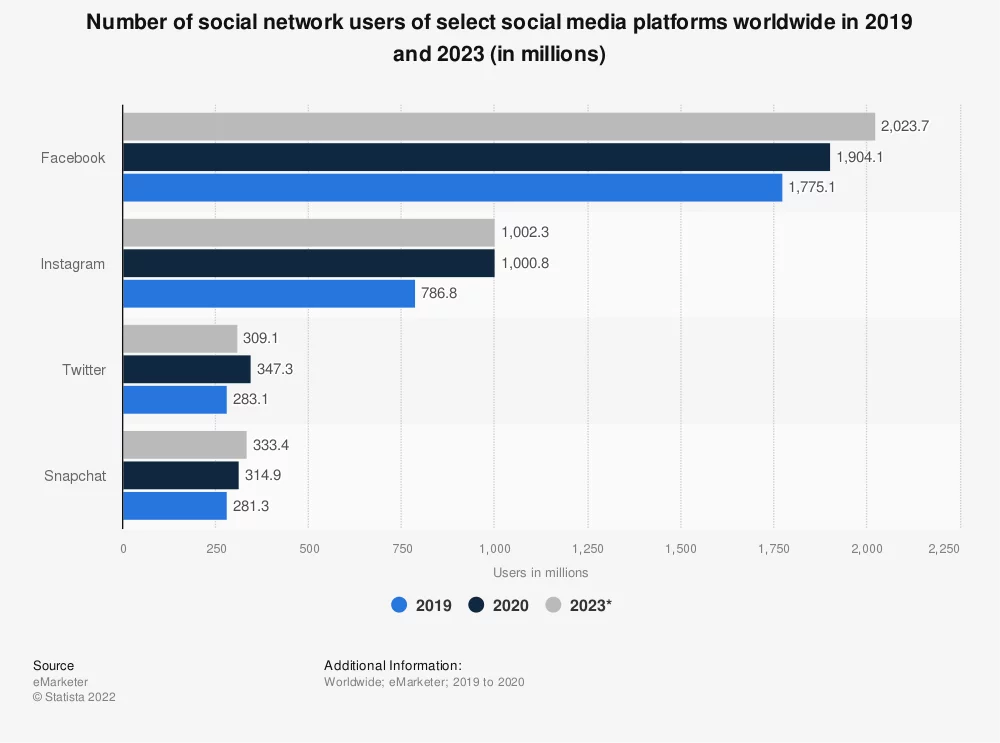
Consider the findings of a study by Buffer, a leading social media management platform. Their research revealed that businesses that implement a consistent posting schedule using scheduling tools witness an average increase of 70% in their engagement rates within just three months. This remarkable jump in engagement not only amplifies brand visibility but also solidifies customer loyalty.
From a global perspective, the impact is equally compelling. Social media schedulers allow content to be disseminated at optimal times, transcending geographical barriers and maximizing engagement. A case in point is Hootsuite’s data, which indicates that posts scheduled at specific peak hours witnessed an up to 57% increase in click-through rates compared to posts shared randomly.
Learn about social media aggregators here.
Benefits of Using Social Media Schedulers:
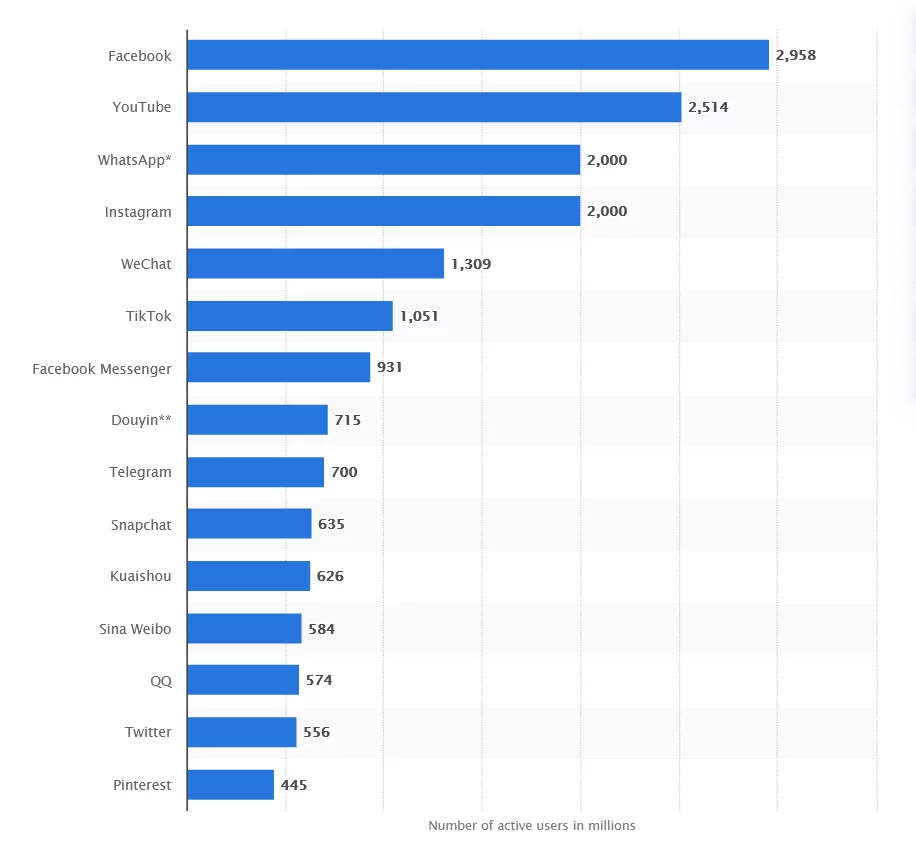
a. Time Efficiency:
Social media schedulers empower you to streamline your content creation process. Instead of creating and posting content in real-time, you can batch-create multiple posts in one sitting and schedule them for future publication. This approach not only saves you time but also allows you to dedicate focused periods to content creation, resulting in higher-quality posts. With your content calendar planned out, you’ll have more time to allocate to other important tasks, such as engaging with your audience or strategizing your next marketing move.
b. Consistency:
Consistency is a cornerstone of successful social media strategies. When your audience knows when to expect content from you, they’re more likely to engage and keep following your updates. Social media schedulers enable you to maintain a regular posting schedule, ensuring that your content is consistently delivered to your followers. This consistency builds trust, reinforces your brand identity, and keeps your audience engaged over time.
c. Optimal Timing:
Posting at the right time can significantly impact the reach and engagement of your posts. Social media schedulers often include features that analyze your audience’s behavior, such as when they’re most active and likely to engage with your content. By leveraging these insights, you can schedule your posts to go live at the optimal times, increasing the chances of your content being seen and interacted with by a larger audience.
d. Global Reach:
If your target audience spans different time zones, reaching them at convenient times can be a challenge. Social media schedulers help overcome this obstacle by allowing you to post content at times that align with different time zones. This ensures that your content reaches your international audience when they’re most likely to be online, increasing your global reach and engagement.
e. Strategic Planning:
Social media schedulers empower you with the ability to plan your content calendar well in advance. This is particularly valuable when you’re running campaigns, launching products, or hosting events. By aligning your posts with these initiatives, you can create a cohesive narrative and build anticipation among your audience. Planning ahead also allows you to allocate resources more effectively and adapt your content strategy based on upcoming events or trends.
Top Social Media Schedulers of 2023:
1. SocialBee – Your Social Media Management Solution
Price: $29/month
Profiles Included: 5 social media profiles
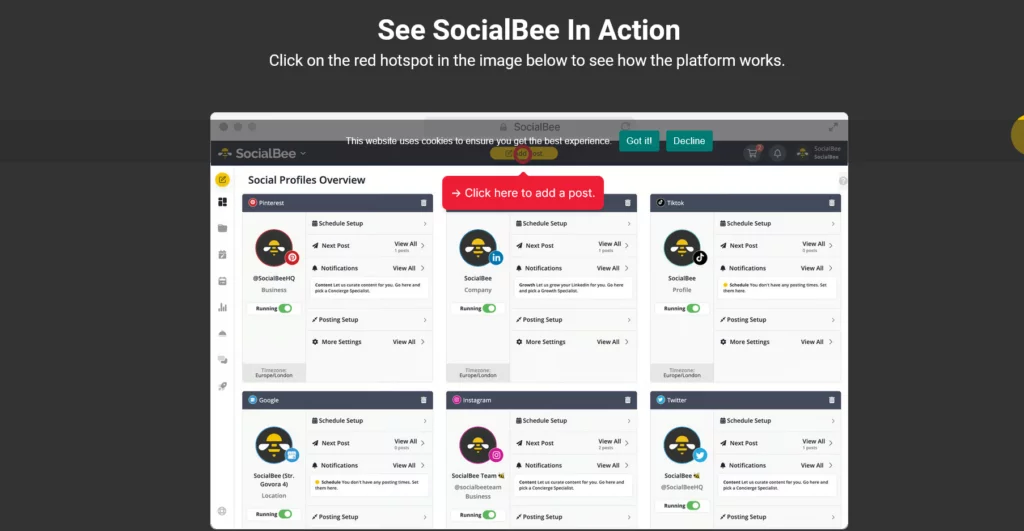
In the rapidly evolving landscape of social media platforms, finding the perfect fit for the specific needs of small businesses can be a daunting task. Fortunately, SocialBee emerges as a comprehensive solution that ticks all the right boxes.
Boasting a range of affordably priced plans, an intuitive user interface, and an array of impressive features, SocialBee stands out as a versatile tool that can elevate both your content strategy and social media workflow.
Pros:
- Efficient Posting Schedule: SocialBee allows you to establish a well-defined posting schedule for your social media content. What’s more, you can gain a real-time preview of your upcoming posts, ensuring a seamless and organized approach to sharing your content.
- Categorized Post Management: Organizing your posts has never been easier. SocialBee enables you to sort your content into distinct categories, tailoring each piece for the nuances of different social media platforms. Once customized, these posts can be automatically disseminated across all your social profiles simultaneously.
- Canva Integration: Enhancing your visual content is a breeze with SocialBee’s integration with Canva. Inside the post editor, you can leverage Canva’s creative tools to craft visually striking graphics that captivate your audience.
Cons:
- Web-Based Nature: It’s worth noting that SocialBee is solely web-based, which may pose limitations for enterprises seeking more integrated solutions.
- AI Image Creator Limitations: Some users have reported issues with the functionality of SocialBee’s AI image creator, which could impact your ability to generate visually appealing content.
2. Hootsuite – Empowering Enterprise-Level Agencies
Price: $739/month
Users Included: 5 users
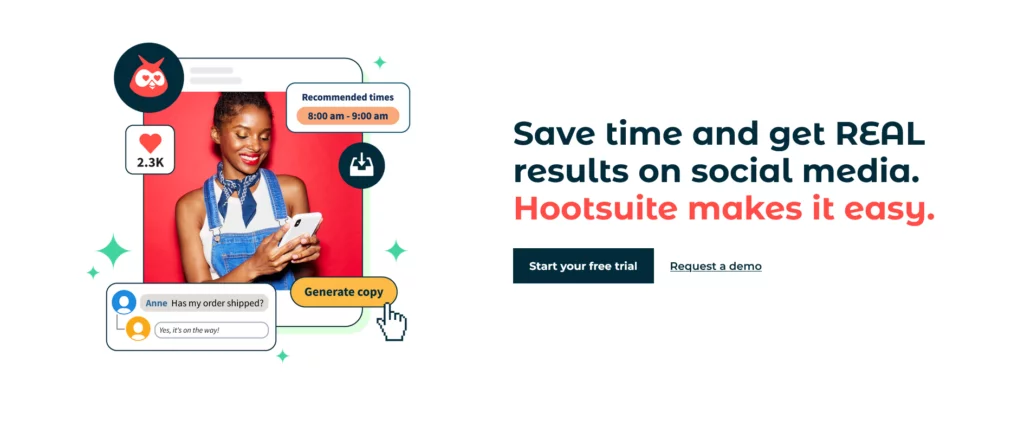
Hootsuite, a robust planner tool, finds its primary user base among enterprise-level agencies. While it offers comprehensive capabilities, it’s important to note that its complexity can pose a challenge for some users. With a longstanding presence in the social media market, boasting over 16 million users globally, Hootsuite has established itself as a key player.
One of its standout features is the ability to schedule posts on major platforms such as Facebook, Twitter, Instagram, LinkedIn, Pinterest, and YouTube. However, the major drawback lies in its steep pricing. This cost can be prohibitive for small businesses, leading us to suggest exploring more budget-friendly Hootsuite alternatives.
Pros:
- Social Streams Feature: Hootsuite excels in its social streams feature, allowing direct engagement with your audience and comprehensive monitoring of social accounts, all conveniently accessible from the Hootsuite dashboard.
- Tailored Analytics: Hootsuite offers account-specific social media analytics, enabling result tracking over different time frames. Additionally, you can craft customized reports that align with your unique requirements.
- Extensive App Integration: Hootsuite boasts connectivity with over 150 apps through its app directory. This facilitates efficient collaboration by giving you the ability to select apps that suit your needs.
Cons:
- Pricing Concerns: Hootsuite’s pricing is often deemed excessive, rendering it inaccessible for many users. The complexity of their dashboard also makes it challenging for newcomers to navigate.
- Feature Costs: While Hootsuite offers numerous features, some are available at an additional cost. This includes access to specific social media account analytics, customizable reports, and using URL shorteners beyond owl.ly.
- Customer Support: Hootsuite’s customer support might not meet prompt expectations. Moreover, prioritized assistance might come at an extra cost.
3. Buffer – Simplified Social Media Publishing
Price: $120/month
Profiles Included: 10 profiles
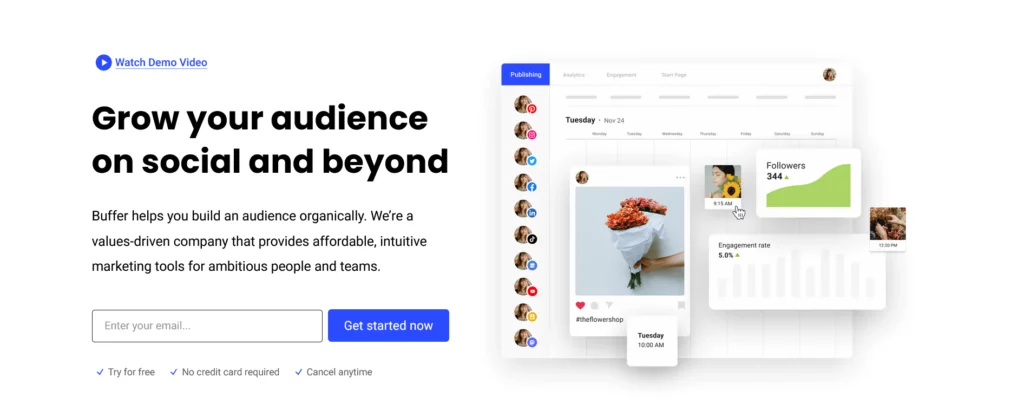
Buffer emerges as another robust publishing application similar to SocialPilot. It enjoys a dedicated user community and seamlessly integrates with major social media platforms, including Facebook, Twitter, LinkedIn, Pinterest, and Instagram.
To provide a comprehensive overview, let’s examine the key strengths of both Buffer and SocialPilot. A notable advantage of Buffer is its integration with WordPress and Chrome, making it a versatile choice. It’s worth noting that Buffer also supports scheduling social media posts on both iOS and Android devices, ensuring flexibility.
Pros:
- User-Friendly Interface: Buffer prides itself on a clean and intuitive user interface, facilitating easy navigation and interaction within the platform.
- Tailored Post Customization: This social posting tool enables you to personalize posts for each social platform, thanks to its tailored posts feature.
- Responsive Customer Support: Buffer stands out by offering prompt customer support that swiftly addresses any issues users might encounter.
Cons:
- Lacking Content Curation: Buffer lacks an essential feature such as a Content Curation tool to discover trending and fresh content for your audience.
- Additional Products with Extra Costs: Buffer offers products like Buffer Reply and Buffer Analyze, requiring additional payments for managing social conversations and accessing in-depth social media analytics, on top of the core Buffer Publish.
- Post Limit for Free Version: In its free iteration, Buffer places a limitation of 10 posts per channel.
4. Sendible – Tailored Social Media Management
Price: $199/month
Users Included: 5 users
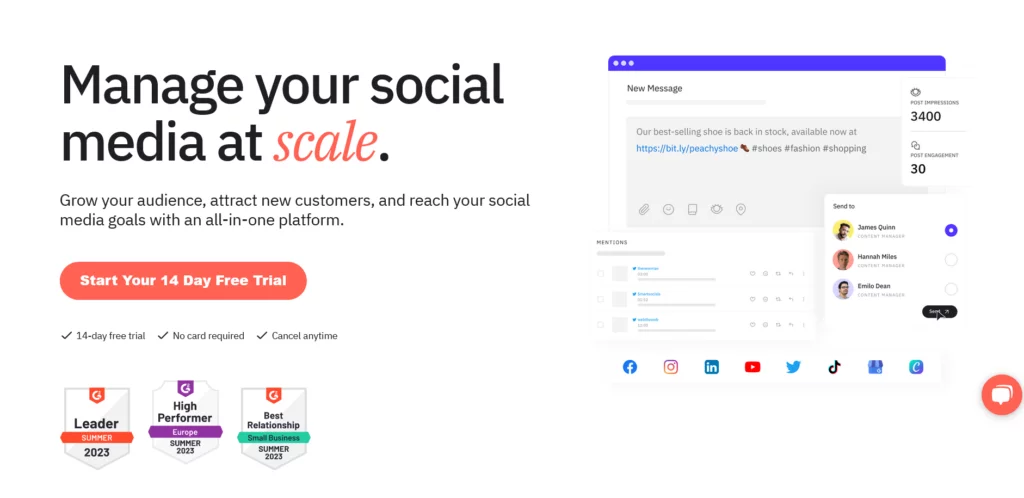
Sendible emerges as a potent tool, strategically designed for efficient social media marketing management across multiple clients, all with a focus on delivering desired outcomes. With a strong agency-centric orientation, Sendible caters adeptly to the dynamic needs of agencies.
Notably, Sendible extends support to a diverse array of platforms including Facebook, Twitter, Instagram, LinkedIn, Google My Business, YouTube, Pinterest, and prominent blogging platforms such as WordPress, Medium, and Tumblr.
For a comprehensive perspective, let’s conduct an extensive comparison of Sendible and SocialPilot, with SocialPilot serving as a benchmark for excellence. Moreover, Sendible excels in monitoring campaign performance. Its features like sentiment analysis and automation lend it a distinctive competitive advantage.
Pros:
- Unified Social Inbox: Sendible boasts a unified Social Inbox that enables vigilant tracking of your brand, competitors, and pivotal industry terms, thereby ensuring you stay ahead. Additionally, you receive notifications via email or Slack for mentions matching your specified criteria.
- In-Depth Custom Reports: Create and dispatch detailed custom reports automatically via email to clients or team members on a daily, weekly, or monthly basis.
- Efficient Delegation: Facilitate streamlined customer service by assigning conversations and delegating messages to team members, all within the Sendible dashboard.
Cons:
- Pricing Complexity: Sendible’s pricing structure is intricately tied to the number of services used. For instance, streaming and publishing to a Facebook page are considered as distinct services.
- Delayed Response Display: When responding to conversations or mentions via Sendible, the immediate display of responses can sometimes be delayed, leading to potential repetition.
- Learning Curve: Sendible requires a certain period of adjustment, as users might initially grapple with its interface. Some users have reported challenges with its dashboard’s user experience.
5. Agorapulse – Collaborative CRM for Effective Social Media Management
Price: $199/month
Users Included: 4 users
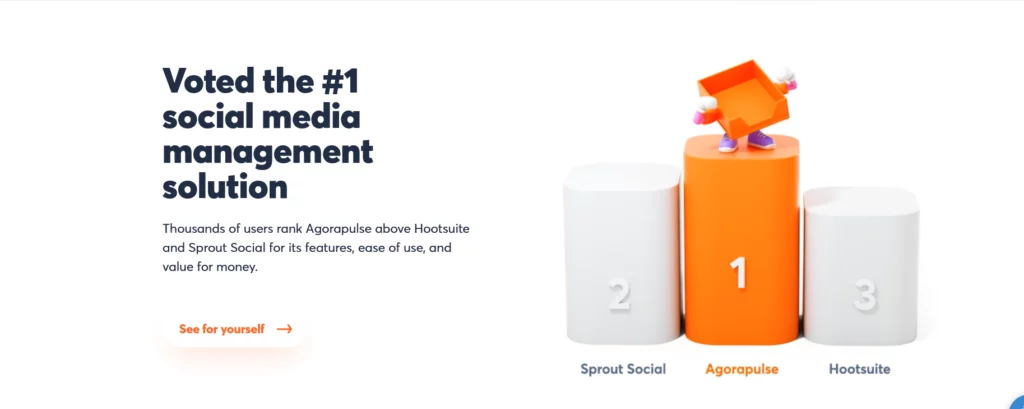
Agorapulse emerges as a versatile CRM solution tailored for agencies and teams seeking streamlined collaboration. It empowers users to engage, listen, collaborate, and gauge the effectiveness of their social media endeavors. With Agorapulse, you can effortlessly manage social media campaigns while benefiting from its robust features.
Agorapulse’s support extends to major social media platforms including Facebook, Twitter, LinkedIn, YouTube, and Instagram. This dynamic scheduling tool also boasts features like bulk scheduling, a unified inbox, and an RSS feed integration.
Pros:
- Content Labeling: Agorapulse allows you to label content for convenient retrieval and analysis purposes, enhancing organization.
- Personalized Message Assignment: The Social Inbox feature facilitates the assignment of messages to clients, complete with customized notes or comments, streamlining communication.
- In-Built CRM: Agorapulse’s integrated CRM empowers you to gain deeper insights into your audience, enabling more informed decision-making.
Cons:
- Basic Reporting: Agorapulse’s reporting feature is somewhat rudimentary. While it allows report downloads in PowerPoint format, its effectiveness is limited.
- User Interface Concerns: Agorapulse’s user interface lacks intuitive design, necessitating improvements for seamless navigation.
- Feature Comparison: When compared to other social media sharing tools in the same price range, Agorapulse’s feature set is relatively limited. Except for bitly, it lacks integration with external apps or tools like Dropbox, Google Drive, or Zapier.
6. Sprout Social – Elevating Corporate Social Media Management
Price: $249/month
User Included: 1 user
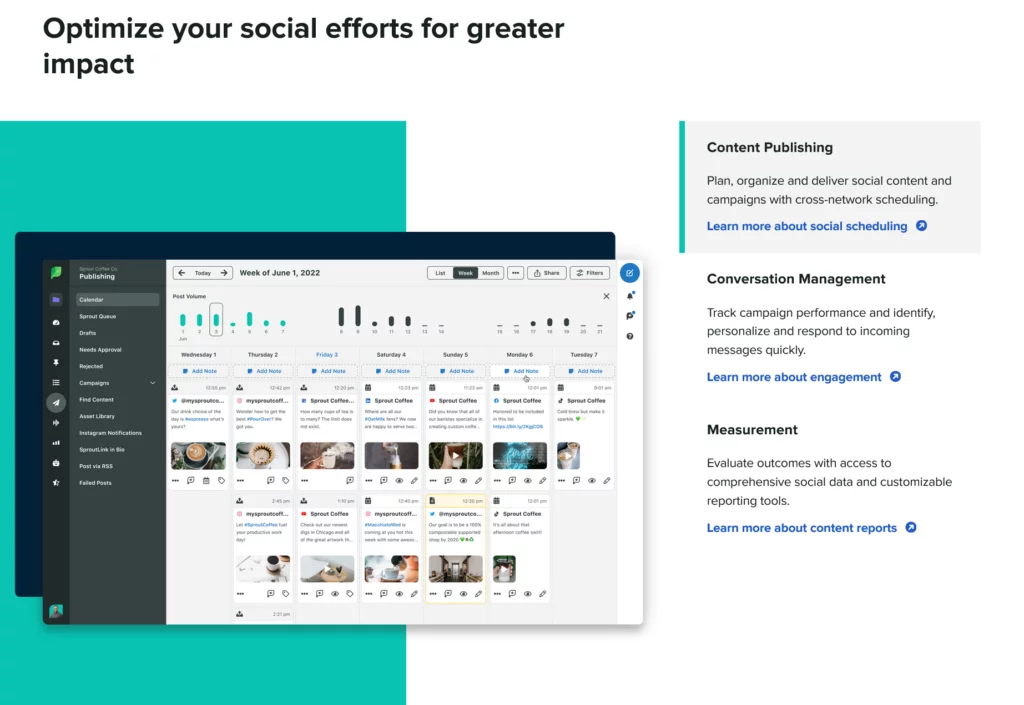
In the realm of social media sharing tools, Sprout Social stands as a close counterpart to Hootsuite. Geared towards corporate use, it provides access to an array of sophisticated features such as a smart inbox, comprehensive social media analytics, and tailor-made reporting. Prominently catering to platforms like Facebook, Twitter, LinkedIn, Instagram, and Pinterest, Sprout Social significantly enhances your workflow efficiency, aiming to steer efforts in the right direction. The value of its analytics is pivotal in gauging your overarching social media performance.
Pros:
- Bot Builder Functionality: Sprout Social’s bot builder tool empowers you to create, operate, and manage chatbots within the Facebook Messenger ecosystem.
- Enhanced Team Collaboration: This social media scheduling tool facilitates seamless team collaboration by grouping team members for streamlined interaction.
- Integrated Support Tools: Sprout Social allows integration with tools like Zendesk, HubSpot, and UserVoice. This empowers support teams to efficiently manage user issues without needing to exit the dashboard.
Cons:
- Costly Team Scaling: Sprout Social’s pricing structure, which charges per invited team member/user, can make it an expensive option for social media post scheduling with teams. (However, there are alternatives to SproutSocial that offer similar features at a more budget-friendly price.)
- Visual Platform Integration Gap: Given its premium price, Sprout Social’s omission of integration with visual platforms like YouTube is noteworthy.
- Unified Inbox Absence: While its inbox is intuitive, Sprout Social lacks a unified inbox. Users must toggle between different social account streams individually.
7. CoSchedule – Elevate Your Publishing Game
Price: $400/month
Users Included: 5 users
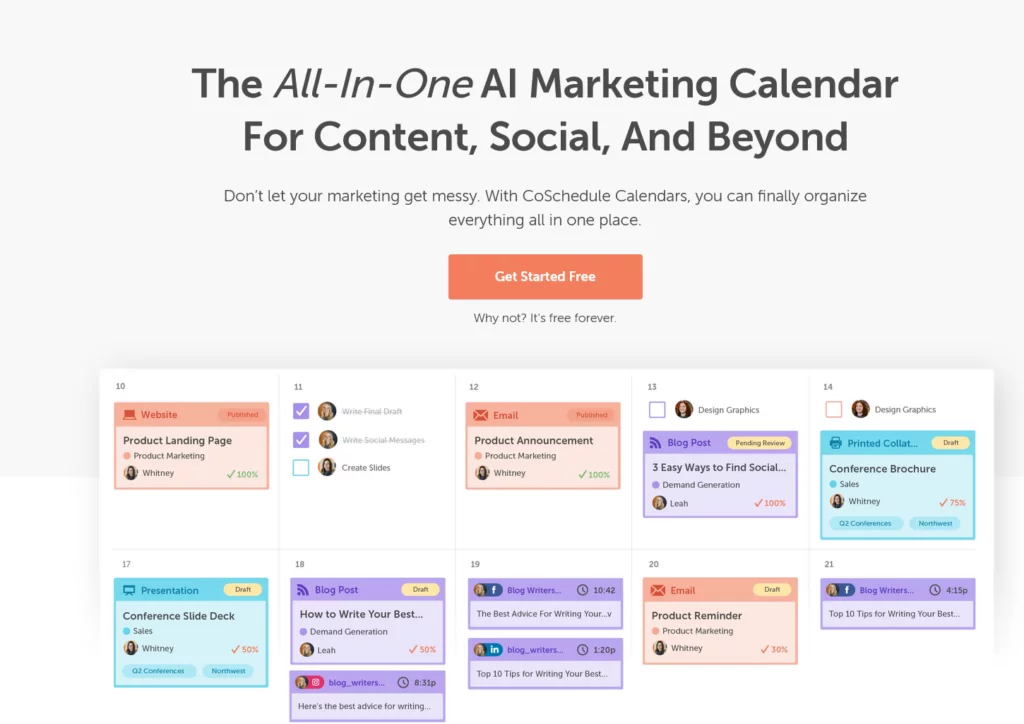
CoSchedule distinguishes itself through its concentrated emphasis on publishing, with its standout feature being the content calendar. This tool empowers you to expertly manage your social profiles on platforms such as Facebook, LinkedIn, Instagram, Pinterest, and Tumblr.
CoSchedule’s versatility extends to seamless integration with blogging platforms like WordPress and HubSpot, facilitating the streamlined organization and publication of your blog posts directly from your CoSchedule account. Moreover, the tool includes a “re-queue” feature enabling the resharing of your top-performing content.
Pros:
- Automated Scheduling Optimization: If you miss a social media posting slot, CoSchedule automatically fills the gap with your highest-performing posts, ensuring consistent engagement.
- Kanban Project Dashboard: CoSchedule’s Kanban Project dashboard offers a visual representation of your team’s tasks and their progress at various stages. Custom statuses can be applied to workflows to suit your team’s specific modus operandi.
Cons:
- Free Plan Limitation: CoSchedule’s free plan offers very basic features.
- Price Point: CoSchedule’s pricing is notably high compared to other scheduling tools available, despite lacking enterprise-level features like social listening and monitoring.
- Integration Shortcomings: CoSchedule’s lack of robust integrations and collaborations with other tools hampers efficiency when working alongside teams to streamline processes.
- ReQueue Feature Constraint: While the ReQueue feature proves beneficial, it comes with constraints, permitting you to queue posts only twice.
8. Zoho Social – Nurturing Growing Businesses
Price: $320/month
Users Included: 5 users

Zoho Social is thoughtfully designed to address the evolving requirements of growing businesses. It empowers collaboration among team members, facilitates brand mention monitoring, and adeptly manages social conversations. Through Zoho Social, you can seamlessly oversee social profiles on Facebook, Twitter, LinkedIn, Instagram, and Google My Business. This social media posting tool boasts exceptional features such as social listening and SmartQ predictions. Notably, Zoho Social leverages profile analytics to recommend optimal posting times, fostering higher engagement rates.
Pros:
- SmartQ Feature: Zoho Social excels by suggesting the most opportune time slots for scheduling social media posts via its SmartQ feature, capitalizing on your audience’s peak activity.
- Integrated CRM Functionality: By embedding CRM integrations, Zoho Social equips you to engage with prospects and cultivate potential leads arising from social media interactions.
- Automated Reporting: Create automated reports tailored to your chosen format and frequency, ready for delivery to clients. Team members can be included in the recipient list, accompanied by personalized messages.
Cons:
- Analytics and Reporting Shortfall: The analytics and reporting feature falls short of expectations, lacking a unified analytics overview.
- RSS Feed Integration Absence: Zoho Social lacks integration with RSS feeds, which is a standard feature across other social media planning tools.
- Pricing and UI Consideration: Given the features and user interface on offer, some users find Zoho Social to be relatively expensive.
9. eClincher – Amplify Your Social Media Campaigns
Price: $425/month
Users Included: 6 users
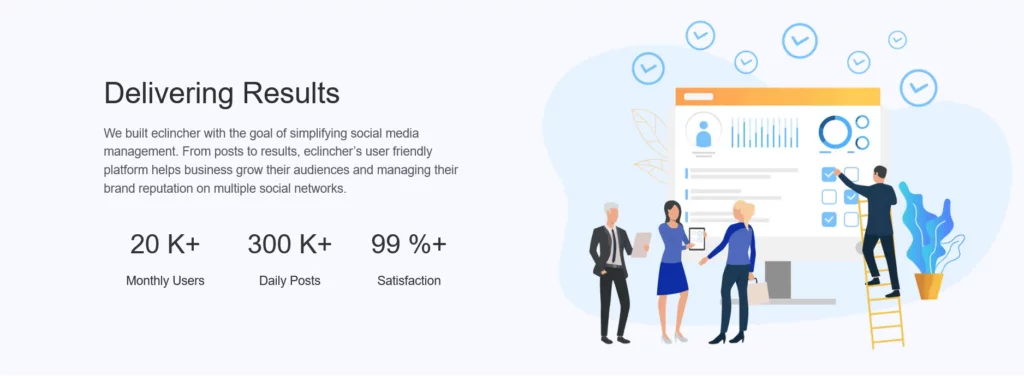
eClincher emerges as a robust platform supporting an array of social networks, including Facebook, Twitter, LinkedIn, Pinterest, Instagram, Google Business Profile, and YouTube. Primarily oriented towards agencies, it facilitates comprehensive social media campaign management, enriched by reporting and analytical capabilities, as well as a unified social inbox.
However, noteworthy is the absence of collaboration features in this social media scheduling tool. Furthermore, eClincher presents a slight learning curve, requiring users to invest time in tutorial exploration to unlock its full functionality.
Pros:
- Influencer Discovery: eClincher introduces a unique feature enabling the identification of top influencers through keyword searches, accompanied by their most impactful content recommendations.
- Centralized Inbox: The platform streamlines monitoring, listening, and competitor activity tracking via a centralized inbox.
- Inbuilt Media Library: eClincher includes an integrated media library, providing a dedicated cloud storage for convenient uploading of images and videos.
Cons:
- User Interface Concerns: eClincher’s user interface lacks in user-friendliness, adopting a rather lackluster and outdated visual approach. The same applies to its mobile app experience.
- Unified Inbox Challenges: While the unified inbox is an asset, it tends to become cumbersome when dealing with multiple social media accounts.
- Pricing Consideration: For small businesses or social media professionals, eClincher’s pricing can be notably steep.
10. MavSocial – Empowering Visual Marketing Strategies
Price: $249/month
Users Included: 5 users
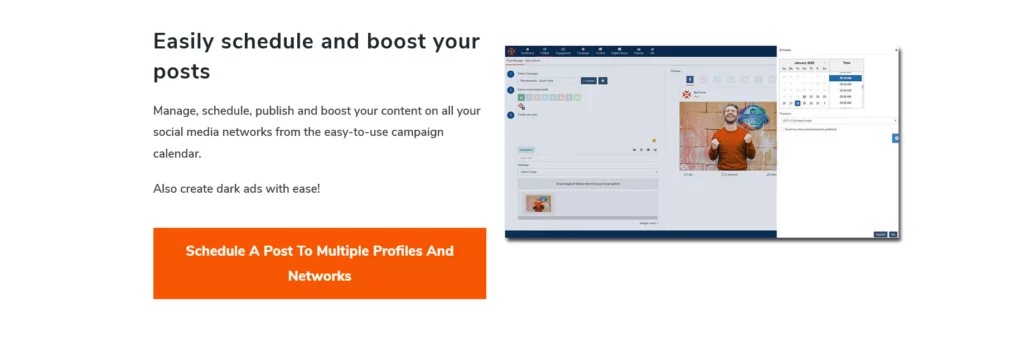
MavSocial stands out as a strategic planner tool that places a strong emphasis on visuals to assist in realizing your visual marketing aspirations. Comprehensive in its support, MavSocial accommodates Facebook, Twitter, LinkedIn, Instagram, YouTube, and Tumblr.
Unveiling a suite of capabilities, MavSocial empowers engagement, listening, analysis, and collaboration. This social posting tool extends a unique offering of stock images, elevating the visual appeal of your posts. Additionally, the tool provides avenues for social listening, contributing to a well-rounded approach.
Pros:
- Dedicated Digital Assets Library: MavSocial introduces a dedicated repository for digital assets encompassing images, videos, and audio. Users can organize personal digital libraries with tags and descriptions.
- In-House Photo Market: The tool features an in-house photo market, enabling perpetual retention of purchased or free media within the MavSocial account’s digital library.
- Inbuilt Photo Editing App: MavSocial hosts an integrated photo editing application, enabling users to enhance images before publication. The tool also facilitates identification of top-performing media and captures cross-platform engagement metrics.
Cons:
- Outdated User Interface: MavSocial’s user interface lags behind in terms of modern design, presenting an outdated aesthetic. Its scheduling structure also involves complexities.
- Glitchy Mobile App: The mobile application exhibits glitches, and certain features available on the web version are inaccessible, thereby necessitating mobile app usage.
- Reporting Limitations: MavSocial lacks an exhaustive reporting feature, limiting the customization potential for reports.
11. Sked Social – Simplified Social Media Scheduling at a Low Cost
Price: $25/month
User Included: 1 user

Sked Social serves as a user-friendly solution for small businesses, streamlining their marketing endeavors. Primarily tailored for Instagram scheduling, it extends support to an array of platforms including Facebook, LinkedIn, YouTube, Twitter, Snapchat, TikTok, and Google Business Profile. Noteworthy is its range of Instagram-focused features, such as the ‘link in bio’ function and shoppable product tagging, which greatly benefits e-commerce enterprises. Beyond scheduling, Sked Social effectively caters to various social media marketing needs, encompassing a social inbox, analytics, reporting, and team collaboration.
Pros:
- Effortless Onboarding: Sked Social stands out for its simplicity in both tool setup and onboarding processes.
- Robust Instagram Features: The tool excels in terms of Instagram-related functionalities, particularly resonating with users.
Cons:
- Occasional Post Delay: Instances of post publishing delays have been reported.
- Custom Reel Cover Scheduling Limitation: The tool lacks the capability to schedule custom covers for Instagram Reels.
12. MeetEdgar – A Unique Approach to Evergreen Posting
Price: $49/month
User Included: 1 user
MeetEdgar stands apart from conventional schedulers by introducing a distinctive approach to social media post scheduling. It specializes in evergreen posting, ensuring your content queue is never depleted. Upon scheduling a post within this social media planner, it is preserved in the library for future reuse. MeetEdgar’s support extends to Facebook, Twitter, Instagram, Pinterest, and LinkedIn. Complemented by a straightforward UI and AI integrations, it facilitates the seamless execution of your social media strategy.
Pros:
- Evergreen Posting Perpetuity: MeetEdgar maintains an evergreen posting queue that ensures the continual re-sharing of your evergreen content.
- Category-Based Posting Schedule: The tool offers a category-driven posting schedule, allowing content to be grouped and scheduled based on specific categories.
Cons:
- Queue Rescheduling Constraint: While content can be scheduled based on categories, the inability to reshuffle posts in the queue for rescheduling at later time slots poses a limitation.
- Limited Features and Network Support: MeetEdgar’s relatively limited feature set and support for only 5 networks prevent it from serving as an all-encompassing solution for marketers.
- Absence of Collaborative Features: Team member addition, social inbox, and in-depth social analytics are notably absent from MeetEdgar’s feature lineup.
- Single Pricing Plan: The tool’s singular pricing plan may be deemed less cost-effective given the specific set of features it offers.
13. SmarterQueue – Continuous Queue Refill Mechanism
Price: $79.99/month
User Included: 1 user
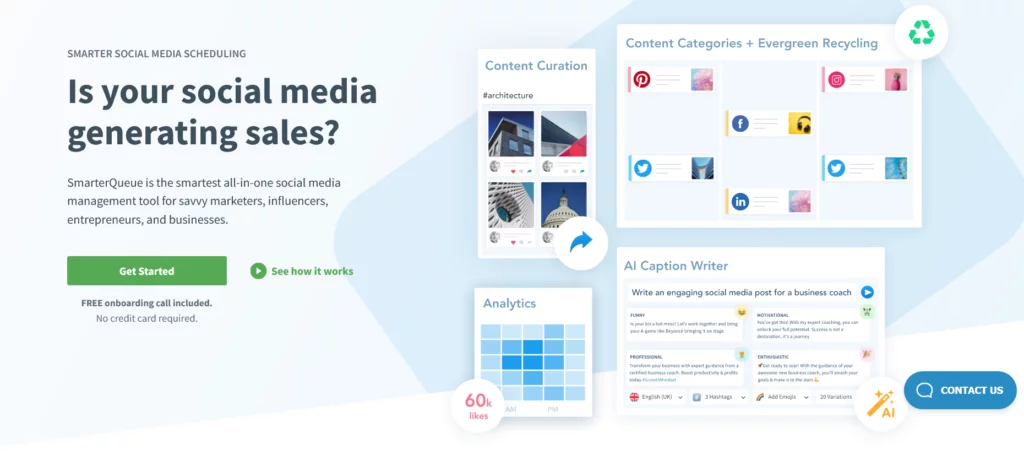
SmarterQueue introduces an alternative perspective on scheduling, sustaining a perpetual content queue through recycling. Supported platforms include Facebook, Twitter, LinkedIn, Instagram, and Pinterest.
Users can conveniently categorize content for efficient access. This social posting tool further recommends a tailored schedule based on profile metrics.
Pros:
- Category-Based Time Slots: SmarterQueue enables easy allocation of time slots to categories and automates the recycling of evergreen posts.
- Variation Creation: The tool permits the creation of post variations for re-queueing, eliminating the need for constantly generating unique content.
Cons:
- Price Consideration: SmarterQueue’s pricing may be regarded as relatively high for the provided features, allowing management of only 25 social accounts at $79.99/month for a single user.
- Lack of Collaborative Features: Collaborative functions, such as team member integration and management of multiple client accounts, are missing. Moreover, in-depth reporting and social inbox functionalities are not available.
- User Interface Concerns: The user interface lacks the intuitiveness and user-friendliness desired by users.
14. StatusBrew – Enhanced Social Media Management
Price: $129/month
Users Included: 5 users
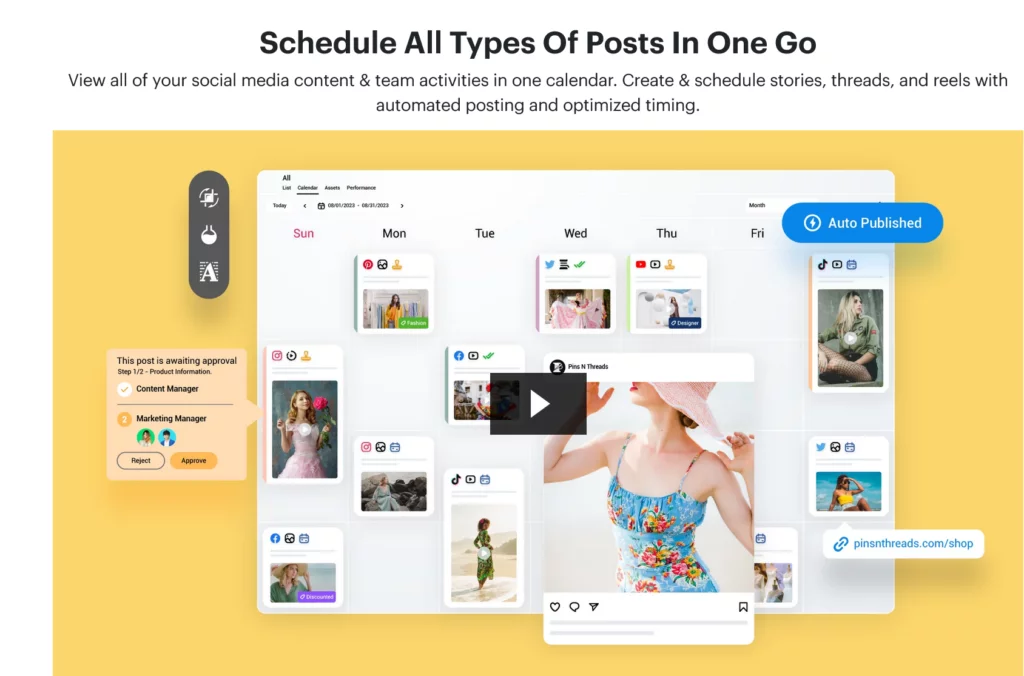
StatusBrew emerges as a premier post scheduler, offering a comprehensive suite of features including social inbox, analytics, and listening capabilities. Its advanced team collaboration functions, encompassing versatile permission settings, set it apart.
The tool supports a range of social media channels including Facebook, Instagram, LinkedIn, and Youtube. Beyond scheduling, StatusBrew extends its utility to ad campaign moderation on Facebook and Instagram, while also integrating security features into its enterprise plans.
Pros:
- Decent Analytics and Reporting: StatusBrew offers commendable analytics and reporting functionalities, catering to data-driven insights.
- Audience Targeting via Social Listening: Leveraging its social listening capabilities, StatusBrew facilitates targeting newer audiences more effectively.
Cons:
- Complex UI: The user interface might appear overwhelming initially, requiring users to invest time in comprehending its feature set.
- Higher Starting Price and Limited Platform Integration: The tool’s initial cost is relatively high, coupled with a restrained selection of platform integrations.
15. Later – Comprehensive Content Planning
Price: $80/month
Users Included: 6 users
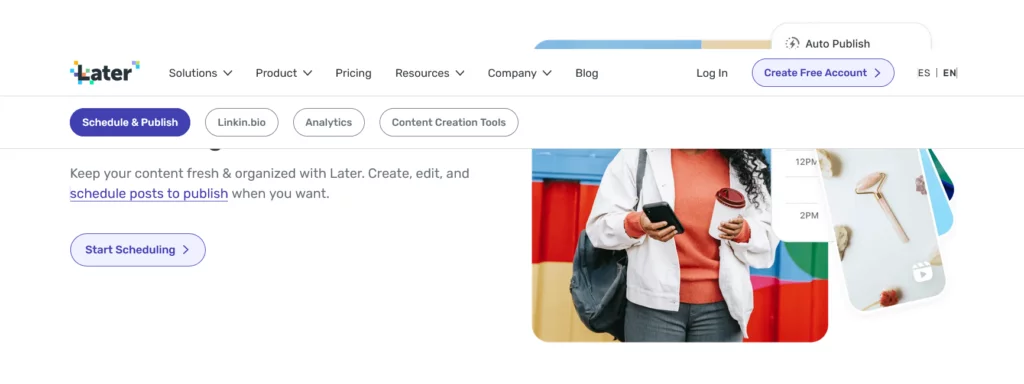
Later enjoys popularity as a robust content planner tool, replete with a myriad of features. While accommodating scheduling for multiple platforms like Instagram, Facebook, Pinterest, TikTok, Twitter, and LinkedIn, its forte remains Instagram posting.
This social media content planning tool introduces convenient features like content research using hashtags and keywords. A visually-driven content calendar facilitates organized planning, while the asset library offers media storage with added functionalities such as notes, labels, and stars for efficient filtering. This library also serves as a repository for evergreen content, allowing frequent scheduling within specified time frames.
Pros:
- Linkin.bio Feature for Traffic Direction: Later incorporates the Linkin.bio feature, facilitating website traffic redirection from Instagram.
- Efficient Hashtag Generation: The tool generates hashtags and tags during social media post scheduling.
Cons:
- Bulk Upload Absence: The absence of bulk upload functionality might be a hindrance for businesses with high-volume posting requirements.
- Image Dependency for Posting: Later mandates an image for social media posts, potentially limiting text-only posts.
Factors to Consider Before Choosing a Social Media Scheduler:
1. Platform Compatibility: Ensure that the scheduler supports all the social media platforms you intend to use. Different platforms have varying features and requirements for scheduling, so confirm that the tool can handle all of them seamlessly.
2. Scheduling Features: Look for a scheduler that offers a variety of scheduling options, such as setting specific dates and times for posts. Additionally, consider features like recurring posts, so you can schedule content to be published regularly.
3. Automation and Integration: Integration with other tools, like customer relationship management (CRM) software or analytics platforms, can streamline your workflow. The ability to automate posting based on triggers or events can also be beneficial.
4. Analytics and Reporting: The scheduler should provide comprehensive analytics on post performance. This includes metrics like engagement rates, click-through rates, follower growth, and the ability to track the success of specific campaigns.
5. User Interface: A user-friendly interface is crucial for easy navigation and efficient scheduling. Look for drag-and-drop functionality, a clear content calendar view, and the ability to preview how posts will appear on each platform.
6. Team Collaboration: If you work with a team, choose a scheduler that supports collaboration. Features like approval workflows, user roles, and the ability to leave comments on scheduled posts can enhance team communication.
7. Content Management: The scheduler should allow you to upload and manage media files, captions, and hashtags seamlessly. Some platforms offer media libraries for easy access to frequently used content.
8. Posting Frequency: Ensure that the scheduler’s limitations align with your posting strategy. If you have a high posting frequency, make sure the tool can handle scheduling a large number of posts without issues.
9. Cost and Pricing Model: Understand the pricing structure. Some tools have tiered pricing based on the number of scheduled posts, users, or features. Evaluate whether the cost is reasonable for your budget and expected usage.
10. Customer Support: Reliable customer support is essential. Check the available support channels (email, chat, phone), response times, and user reviews about the quality of support provided.
11. Security: Ensure that the scheduler uses secure connections (HTTPS) and follows best practices for data encryption. The tool should also have measures in place to protect your social media account credentials.
12. Mobile Accessibility: If you need to manage social media on the go, consider a scheduler with a mobile app or a responsive web interface that works well on mobile devices.
13. Trial Period: Take advantage of free trials to explore the scheduler’s features and functionality. This hands-on experience will help you determine if the tool suits your needs.
14. Reviews and Recommendations: Research user reviews on platforms like Capterra, G2 Crowd, and Trustpilot. Seek recommendations from colleagues who are already using social media schedulers to gain insights into their experiences.
15. Compliance and Policies: Ensure that the scheduler’s practices align with the terms of service of the social media platforms you’re using. Non-compliance can lead to issues such as content removal or account suspension.
16. Scalability: If you plan to expand your social media presence in the future, consider whether the scheduler can accommodate your growth in terms of the number of accounts and posts.
Best Practices for Social Media Scheduling:
1. **Personalize Your Message:**
While automation is convenient, avoid the pitfall of sounding robotic. Personalize each message to resonate with your audience. Tailor your tone, language, and even emojis to match your brand’s personality and your audience’s preferences. A personalized touch can make your posts feel more genuine and relatable.
2. **Utilize Analytics:**
Leverage the built-in analytics provided by scheduling tools. These insights can help you understand how your audience interacts with your content. Analyze the performance of your posts, identify engagement patterns, and track metrics like likes, shares, and comments. Use this data to refine your content strategy and enhance your reach over time.
3. **Experiment with Posting Times:**
Every audience is unique, and their online behavior varies. Experiment with different posting times to determine when your posts garner the most engagement. While scheduling tools can help you post at optimal times, be willing to test different time slots and analyze the results to find the sweet spot for your specific audience.
4. **Conduct A/B Testing:**
A/B testing involves comparing two versions of a post to see which one performs better. Test different elements such as headlines, images, captions, and calls to action. Through experimentation, you can learn what resonates most with your audience and refine your content accordingly.
5. **Blend Automation with Real-Time Posts:**
While automation streamlines your posting process, don’t rely solely on scheduled content. Real-time engagement is crucial for building authentic relationships. Participate in conversations, respond promptly to comments, and address queries in real time. This human touch adds a personal dimension to your social media strategy.
6. **Adapt to Trends and Events:**
While scheduling your content in advance is advantageous, remain flexible. Keep an eye on current events, industry trends, and relevant holidays. This allows you to pivot your content to remain relevant and capitalize on timely opportunities.
7. **Maintain a Mix of Content Types:**
Variety is key to keeping your audience engaged. Alternate between different content types, such as images, videos, articles, and infographics. This diversification maintains the visual appeal of your feed and caters to different preferences.
8. **Review and Update Content Regularly:**
Periodically review your scheduled content and update it as needed. If circumstances change, you may need to revise your messaging or swap out content to ensure it’s aligned with your current goals.
Conclusion:
Social media schedulers are powerful allies for those seeking to harness the potential of social platforms effectively. By combining the convenience of scheduled posting with genuine, timely interactions, individuals and businesses can strike a balance that results in meaningful connections, increased brand visibility, and overall digital success. The heart of social media beats with authenticity, connection, and humanity. So, let us wield these tools not as a crutch but as a companion, allowing our true selves to shine through the pixels and algorithms.
FAQs on Social Media Schedulers:
Is it better to schedule posts or post in real-time?
Both scheduling posts and real-time posting have their advantages. Scheduling allows for strategic planning and consistent content distribution, while real-time posting enables immediate interactions and engagement during trending moments.
Can I schedule posts for different time zones?
Yes, many social media schedulers allow you to schedule posts based on different time zones, helping you reach your global audience effectively.
What are the risks of over-scheduling content?
Over-scheduling content can lead to a lack of real-time engagement and personal interactions, potentially making your social media presence feel robotic or disconnected.
Can I edit or delete scheduled posts?
Yes, most schedulers allow you to edit or delete scheduled posts before they go live, providing flexibility in adapting to changes or unforeseen events.



